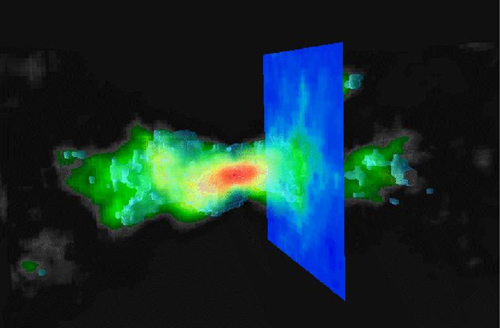
Plate 6: A disturbance in the Grid.
 Plate 6: A quark and an antiquark have been injected from the left of this image. They soon establish a dynamic equilibrium, with the energy of the disturbance confined to a small spatial region, moving through time.
Plate 6: A quark and an antiquark have been injected from the left of this image. They soon establish a dynamic equilibrium, with the energy of the disturbance confined to a small spatial region, moving through time.
The Grid fluctuations have been averaged over, leaving only the net distribution of excess energy. By taking a slice, we find the energy distribution inside the particle being reproduced: in this case, a &pi meson. The total energy gives the mass of the &pi meson, according to Einstein's second law.
More about this image
This mathematical simulation of a pion was created by physicist Greg Kilcup of the Lattice QCD group at Ohio State University. As the group's webpage points out, "Lattice QCD is the subfield of particle theory which attempts to solve QCD problems by approximating spacetime with a discrete grid. Once they are put on a grid, these problems can be attacked by a variety of means, most often involving numerical methods on (super-)computers. The approach was invented by OSU's own Ken Wilson in 1974, and has since evolved into a major discipline within particle physics."
Sharp-eyed readers may also notice that Greg Kilcup is among those being thanked by Derek Leinweber for his contributions to the animation captured in Plate 4.
Use of this image requires prior authorization from Brookhaven National Laboratory's STAR collaboration.